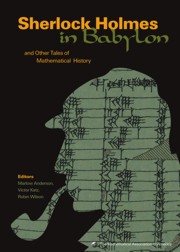Book contents
- Frontmatter
- Introduction
- Contents
- Ancient Mathematics
- Medieval and Renaissance Mathematics
- The Seventeenth Century
- Foreword
- An Application of Geography to Mathematics: History of the Integral of the Secant
- Some Historical Notes on the Cycloid
- Descartes and Problem-Solving
- René Descartes' Curve-Drawing Devices: Experiments in the Relations Between Mechanical Motion and Symbolic Language
- Certain Mathematical Achievements of James Gregory
- The Changing Concept of Change: The Derivative from Fermat to Weierstrass
- The Crooked Made Straight: Roberval and Newton on Tangents
- On the Discovery of the Logarithmic Series and Its Development in England up to Cotes
- Isaac Newton: Man, Myth, and Mathematics
- Reading the Master: Newton and the Birth of Celestial Mechanics
- Newton as an Originator of Polar Coordinates
- Newton's Method for Resolving Affected Equations
- A Contribution of Leibniz to the History of Complex Numbers
- Functions of a Curve: Leibniz's Original Notion of Functions and Its Meaning for the Parabola
- Afterword
- The Eighteenth Century
- Index
- About the Editors
The Crooked Made Straight: Roberval and Newton on Tangents
from The Seventeenth Century
- Frontmatter
- Introduction
- Contents
- Ancient Mathematics
- Medieval and Renaissance Mathematics
- The Seventeenth Century
- Foreword
- An Application of Geography to Mathematics: History of the Integral of the Secant
- Some Historical Notes on the Cycloid
- Descartes and Problem-Solving
- René Descartes' Curve-Drawing Devices: Experiments in the Relations Between Mechanical Motion and Symbolic Language
- Certain Mathematical Achievements of James Gregory
- The Changing Concept of Change: The Derivative from Fermat to Weierstrass
- The Crooked Made Straight: Roberval and Newton on Tangents
- On the Discovery of the Logarithmic Series and Its Development in England up to Cotes
- Isaac Newton: Man, Myth, and Mathematics
- Reading the Master: Newton and the Birth of Celestial Mechanics
- Newton as an Originator of Polar Coordinates
- Newton's Method for Resolving Affected Equations
- A Contribution of Leibniz to the History of Complex Numbers
- Functions of a Curve: Leibniz's Original Notion of Functions and Its Meaning for the Parabola
- Afterword
- The Eighteenth Century
- Index
- About the Editors
Summary
Introduction
In October 1665, about two years after he had first read a mathematics book, Isaac Newton began investigating a method for finding the tangents to “mechanical” curves. He can have known only vaguely that he was following a path trod previously by several outstanding mathematicians, Torricelli, Descartes, Roberval, and Barrow among them. In his ignorance of the details of their work, Newton stumbled before setting himself firmly on the way to his calculus. As he progressed, he overcame the inadequate mathematical language that had kept others from expressing—sometimes from even thinking—their ideas clearly.
Newton's method found tangents by regarding a curve as the trajectory of a moving particle, so that the velocity vector lies along the tangent. Sometimes one can easily find the velocity vector, however, by decomposing the given motion into simpler ones with known velocity vectors. This method of finding tangents to curves by decomposing the velocity vector is often called the kinematic method. Newton's first manuscript on the kinematic method included three examples of curves that had traditionally been described by the composition of motions: the spiral of Archimedes, the cycloid, and the quadratrix. In addition to these mechanical curves, described as trajectories, Newton also discussed the ellipse, a so-called geometrical curve.
Newton had not been the first to consider composition of motions in general or any of these particular examples. Of course, the general idea of composition of motions goes back to the ancient Greeks, as the examples of the Archimedean spiral and the quadratrix show.
- Type
- Chapter
- Information
- Sherlock Holmes in BabylonAnd Other Tales of Mathematical History, pp. 228 - 234Publisher: Mathematical Association of AmericaPrint publication year: 2003



